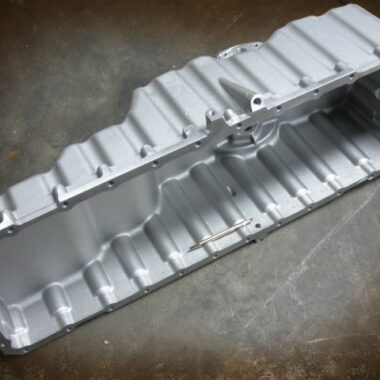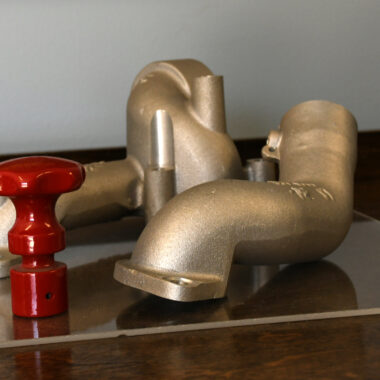Grasping the Craft: Professional Tips for Flawless Aluminum Casting Results
In the world of aluminum spreading, know-how and accuracy are vital to achieve flawless results. Grasping the craft calls for a meticulous understanding of the devices and equipment at one's disposal, an eager eye for preparing the light weight aluminum alloy to exact requirements, and a deft hand in utilizing ideal spreading techniques.
Necessary Devices and Equipment
Light weight aluminum spreading calls for details tools and devices to make certain precision and effectiveness in the process. Important devices consist of a crucible, mold and mildew, heater, and ladle. The crucible, normally made of graphite or ceramic materials, stands up to heats required to thaw light weight aluminum. A well-insulated furnace with the ability of reaching temperatures over 1200 ° C is necessary to dissolve the steel. The mold and mildew, frequently made of steel or sand, shapes the liquified aluminum right into the wanted form. A ladle is used to transfer the liquid metal from the crucible to the mold without spillage.
Furthermore, devices like tongs, handwear covers, and aprons are needed to make certain the safety and security of drivers functioning with liquified light weight aluminum. Tongs give a secure grip when handling warm crucibles and molds, while heat-resistant handwear covers and aprons protect versus unintentional burns. Correct air flow systems are also vital to get rid of fumes and make sure a risk-free functioning atmosphere. Investing in top notch devices and devices not just improves the precision of light weight aluminum spreading however also adds to an extra effective and safe manufacturing process.
Preparing the Light Weight Aluminum Alloy
To make sure the success of the aluminum casting procedure, precise prep work of the alloy is paramount. The initial step in preparing the aluminum alloy is to very carefully select the ideal type of aluminum based on the features required for the last item. Elements such as toughness, rust resistance, and machinability require to be taken into consideration when choosing the alloy. As soon as the alloy kind is identified, it is necessary to properly clean the aluminum to get rid of any kind of pollutants that could affect the casting high quality. This can be done via methods like purification, degassing, and fluxing.
After cleaning, the following crucial action is to heat up the aluminum to the suitable temperature for casting. Generally, thorough prep work of the aluminum alloy sets the structure for an effective casting procedure and premium end outcomes.
Optimal Casting Techniques
Applying specific casting methods is essential for accomplishing high-quality outcomes in aluminum casting processes. One critical technique is ensuring correct mold prep work. This includes precise cleaning and finishing of the mold and mildew to protect against light weight aluminum from sticking and make sure smooth casting. In addition, regulating the putting temperature level is essential. The light weight aluminum needs to be heated to the optimal temperature to minimize problems like shrinkage and porosity in the last actors.
Furthermore, preserving constant putting rate and stress is vital to achieving uniformity in the actors piece. Slow-moving and stable pouring assists protect against turbulence and air entrapment, which can result in flaws. An additional essential element is using degassing representatives to remove pollutants and gases from the molten light weight aluminum, leading to a cleaner final product.

Achieving Smooth Surface Finishes
For manufacturers seeking to enhance the visual appeal and quality of their aluminum spreadings, achieving smooth surface finishes is an essential element complying with specific spreading techniques and appropriate cooling procedures. One secret technique to attain smooth surface finishes is by using high-quality molds that are appropriately prepared and maintained. The mold surface area ought to be meticulously cleansed and coated with launch agents to prevent flaws moving onto the actors light weight aluminum during the cooling process.
In addition, controlling the cooling price of the aluminum casting is critical for attaining a smooth surface finish. Quick air conditioning can lead to thermal gradients that cause appear issues, while slow-moving air conditioning might create microstructural concerns - aluminum casting illinois. By applying controlled air conditioning processes, such as making use of air or water quenching methods, suppliers can make sure that the aluminum strengthens uniformly, lowering the probability of surface blemishes
In addition to mold and mildew top quality and cooling treatments, post-casting treatments like shot blasting or chemical etching can better fine-tune the surface coating of aluminum spreadings. These techniques assist smoothen out any type of remaining roughness or pollutants, resulting in a remarkable appearance that fulfills the best quality requirements.
Quality Control and Troubleshooting

In the world of troubleshooting, it is necessary to have a comprehensive understanding of typical defects that can happen throughout aluminum spreading, such as porosity, surface area, or shrinking abnormalities. By carrying out source evaluation and applying corrective actions, manufacturers can stop these defects from persisting in future spreading runs. Effective fixing not only improves the general quality of go to my blog cast light weight aluminum products but additionally enhances procedure efficiency and lowers production prices. Constant renovation through high quality control and repairing methods is basic to accomplishing remarkable outcomes in light weight aluminum casting.
Verdict
Finally, understanding the craft of aluminum spreading calls for crucial devices and equipment, correct prep work of the aluminum alloy, optimum casting strategies, accomplishing smooth surface coatings, and carrying out quality assurance actions. By complying with these expert pointers, perfect outcomes can be accomplished in aluminum spreading processes. Quality assurance and troubleshooting are necessary aspects to think about to ensure top notch and consistent lead to light weight aluminum casting jobs.
The first step in preparing the light weight aluminum alloy is to thoroughly pick the appropriate type of light weight aluminum based on the qualities needed for the last product.Carrying out specific casting strategies is important for accomplishing high-quality results in light weight aluminum spreading processes. By grasping these optimum casting methods, manufacturers can continually produce perfect light weight aluminum spreadings.
For manufacturers seeking to enhance the visual allure and top quality of their aluminum castings, accomplishing smooth surface area coatings is a vital facet complying my review here with exact spreading methods and proper cooling procedures.In final thought, grasping the craft of aluminum casting requires vital devices and devices, appropriate prep work of the light weight aluminum alloy, ideal casting methods, accomplishing smooth surface finishes, and carrying out high quality control procedures.